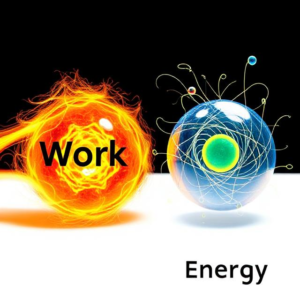Work and energy are fundamental concepts in physics that are closely related. They help explain how things move, change, and interact with forces. Here’s a breakdown of what they mean:

1. Work
Work is done when a force acts on an object and causes it to move in the direction of that force. In simpler terms, work is the energy transferred to or from an object via the application of force.
- Formula:
Where:
is work,
is the force applied,
is the displacement (distance moved) of the object,
is the angle between the force and the direction of movement.
Key points:
- If the force is applied in the same direction as the motion (0° angle), work is positive.
- If the force is opposite to the direction of motion (180° angle), work is negative (for example, when you’re stopping a moving object).
- If there is no displacement, no work is done, even if a force is applied (like pushing on a wall without it moving).
Example:
- If you lift a book (say, 2 N) a distance of 1 meter, the work done is:
(Joule is the unit of work).
2. Energy
Energy is the capacity to do work. It is what enables objects to move, change, or cause things to happen. There are different types of energy, but the most important ones in classical mechanics are kinetic energy and potential energy.
Kinetic Energy (KE)
Kinetic energy is the energy an object has due to its motion.
- Formula:
Where:
is kinetic energy,
is the mass of the object,
is the velocity (speed) of the object.
- Key points:
- The faster an object moves, the more kinetic energy it has.
- If the object is stationary, its kinetic energy is zero.
Example:
- A 2 kg object moving at 3 m/s would have:
Potential Energy (PE)
Potential energy is the energy stored in an object due to its position or state.
- Formula (for gravitational potential energy):
Where:
is potential energy,
is the mass of the object,
is the acceleration due to gravity (approximately 9.8 m/s²),
is the height of the object above the ground.
- Key points:
- The higher an object is (relative to a reference point), the more gravitational potential energy it has.
- If you lift a book to a shelf, you increase its potential energy, and if you drop it, the potential energy is converted into kinetic energy as it falls.
Example:
- A 2 kg object at a height of 5 meters would have:
3. Work-Energy Theorem
This theorem connects work and energy. It states that the work done on an object is equal to the change in its kinetic energy.
- Formula:
Where:
is the work done,
is the change in kinetic energy of the object.
This means that if you apply a force to an object and it speeds up, the work you did on it is transformed into the object’s kinetic energy.
4. Conservation of Energy
Energy cannot be created or destroyed, only transformed from one form to another. This is called the conservation of energy.
- For example, when a ball is dropped from a height, its potential energy is converted into kinetic energy as it falls.
- At the peak, the ball has maximum potential energy and zero kinetic energy, and just before it hits the ground, it has maximum kinetic energy and minimal potential energy.
Summary
- Work is done when a force causes displacement.
- Energy is the ability to do work. Kinetic energy is energy due to motion, and potential energy is stored energy based on position.
- The Work-Energy Theorem states that the work done on an object changes its kinetic energy.
- Energy is conserved: it can’t be created or destroyed, only transformed.











